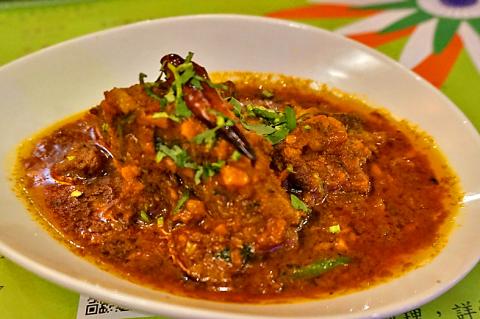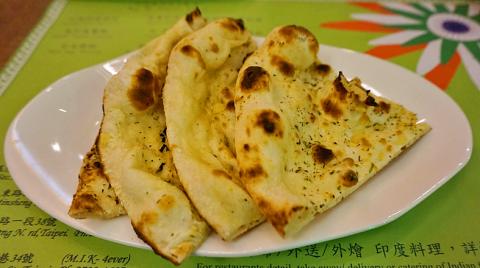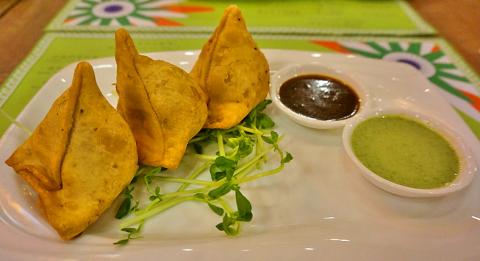Mayur Indian Kitchen tries to be a bit of everything — North Indian and South Indian cuisine, vegetarian and non-vegetarian, halal and non-halal. They have four branches, each with a different menu and concept ranging from buffet to fine dining.
While I understand the idea of wanting to showcase India’s culinary diversity, my experience has been that restaurants who cultivate a niche tend to fair much better. That being said, the dishes were still artful and flavorful, and lacked the taste of being mass produced that many restaurants who try to do a bit of everything generally fall victim to.
I dined at Mayur Indian Kitchen’s newest branch on Tonghua Street (通化街). Being technically a buffet restaurant, there are no frills, just simple red and green walls, mirrors and colorful plates. The bar top is lined with endless bottles of spices. Though modest and compact, the establishment exudes a warm, neighborhood vibe, and by virtue of its location near Tonghua Night Market (通化夜市), well-marinated pork chops is a welcome option to greasy pork sausages.

Photo: Dana Ter, Taipei Times
My dining companion and I opted for a la carte. The chef and owner, Mayur Srivastava, helped us thread through the exhaustive menu and recommend a few dishes — meat for me, vegetarian for my friend.
Of course, every Indian meal needs naan bread for dipping, so we decided on the garlic naan (NT$65). It was served fresh from the oven, crisp, fluffy and charred on the edges, the garlicy aroma adding an extra punch to the curries we paired it with. It worked well with the savory ginger taste of the chana masala (NT$245) for instance. The crunchy chickpeas were soaked in a mild curry grinded with various spices, onions and tomatoes, while small bits of ginger gave it added zest.
I quite fancied the sauces that were served with the Punjabi vegetable samosas (NT$150) — in fact, more than the samosas themselves. Both are homemade. One is a mildly sweet tamarind sauce, and the other, yogurt blended with coriander, mint, spinach and some spices. The coriander and mint were quite evident in the yogurt sauce, though not overwhelming so, but just enough to bring more pungency to the samosas. The samosa skin was not that crispy, and the potatoes and peas were quite a mouthful to digest. It was still done quite well, though the yogurt sauces were the stars of this show.

Photo: Dana Ter, Taipei Times
For vegetarians, I recommend the Tandoori vegetables (NT$280). My vegetarian friend devoured the roasted veggies, dipping each piece of mushroom, capsicum and beet into the sweet tamarind sauce. The veggies were freshly marinated and roasted in a Tandoori oven, which gave it a tantalizingly charred quality without being overcooked. The best part, though, was the cooked apple hidden inside the mountain of veggies. It was unexpected but refreshing, its softer texture complementing the capsicums.
Now, on to the meat. The chicken tikka masala (NT$325), the Indian-British fusion that was named a UK national dish in 2001, was slightly different than what I remembered eating during my graduate school days in London. There were much more vegetables, and not as much curry. While I did not mind the added veggies — the tossed capsicums, peppers and onions mixed with spices were fragrant and crunchy — I would have preferred a creamier, heavier sauce. The roasted chicken was still elegantly done, tender and chewy.
The beef vindaloo (NT$350) was one of my favorite meat dishes. The strips of beef were nicely shredded and tender. The Goan-style curry it was soaked in was a delectable blend of sour and spicy. Also worth sampling is the roasted pork chops (NT$350). Marinated in barbecue sauce and served with fennel seeds, the pork chops tasted naturally sweet and were slightly charred and crisp around the edges.

Photo: Dana Ter, Taipei Times
Definitely check out Mayur Indian Kitchen’s Tonghua Street branch if you’re looking for a full, satisfying meal of curries and veggies. Sometimes, more is more.

April 14 to April 20 In March 1947, Sising Katadrepan urged the government to drop the “high mountain people” (高山族) designation for Indigenous Taiwanese and refer to them as “Taiwan people” (台灣族). He considered the term derogatory, arguing that it made them sound like animals. The Taiwan Provincial Government agreed to stop using the term, stating that Indigenous Taiwanese suffered all sorts of discrimination and oppression under the Japanese and were forced to live in the mountains as outsiders to society. Now, under the new regime, they would be seen as equals, thus they should be henceforth

Last week, the the National Immigration Agency (NIA) told the legislature that more than 10,000 naturalized Taiwanese citizens from the People’s Republic of China (PRC) risked having their citizenship revoked if they failed to provide proof that they had renounced their Chinese household registration within the next three months. Renunciation is required under the Act Governing Relations Between the People of the Taiwan Area and the Mainland Area (臺灣地區與大陸地區人民關係條例), as amended in 2004, though it was only a legal requirement after 2000. Prior to that, it had been only an administrative requirement since the Nationality Act (國籍法) was established in

With over 80 works on display, this is Louise Bourgeois’ first solo show in Taiwan. Visitors are invited to traverse her world of love and hate, vengeance and acceptance, trauma and reconciliation. Dominating the entrance, the nine-foot-tall Crouching Spider (2003) greets visitors. The creature looms behind the glass facade, symbolic protector and gatekeeper to the intimate journey ahead. Bourgeois, best known for her giant spider sculptures, is one of the most influential artist of the twentieth century. Blending vulnerability and defiance through themes of sexuality, trauma and identity, her work reshaped the landscape of contemporary art with fearless honesty. “People are influenced by

The remains of this Japanese-era trail designed to protect the camphor industry make for a scenic day-hike, a fascinating overnight hike or a challenging multi-day adventure Maolin District (茂林) in Kaohsiung is well known for beautiful roadside scenery, waterfalls, the annual butterfly migration and indigenous culture. A lesser known but worthwhile destination here lies along the very top of the valley: the Liugui Security Path (六龜警備道). This relic of the Japanese era once isolated the Maolin valley from the outside world but now serves to draw tourists in. The path originally ran for about 50km, but not all of this trail is still easily walkable. The nicest section for a simple day hike is the heavily trafficked southern section above Maolin and Wanshan (萬山) villages. Remains of